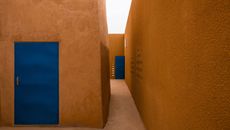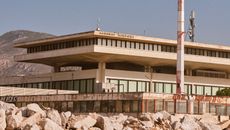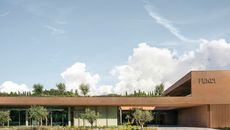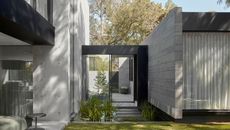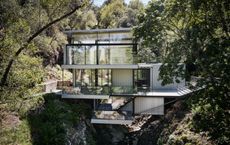Senegal’s Mamy Tall on city planning, bioclimatic construction and heritage
Mamy Tall from Senegal is part of our series of profiles of architects, spatial designers and builders shaping West Africa's architectural future
- (opens in new tab)
- (opens in new tab)
- (opens in new tab)
- Sign up to our newsletter Newsletter

Mamy Tall explains: ‘I have always been passionate about architecture, I have always imagined it as a humanistic profession. I dedicated my work to informing people about the importance of planning and maintaining cities, to raise awareness of bioclimatic construction, to open the debate about heritage and its place in our societies, to create bridges between architecture and fashion, to bring solutions to urban problems, and finally, to understand our political system and its impact on the exercise of our trade.’

West African studios: Mamy Tall
Tall grew up in Togo and trained as an architect in Montreal, Canada, before returning to Africa and making Senegal her home. The dynamic designer enjoys multitasking and this becomes immediately clear when she starts listing her multitude of undertakings. She is the founder of Weex Tall, a Dakar studio that consolidates her various activities and interests: Lives, a platform she co-founded, which promotes African destinations and their creative ecosystem; a documentary series; collaborations in fashion, which considers her second passion after architecture; photography; and exhibition design.
Tall also works at the Senegalese government’s Office of Architecture and Conservation of National Palaces, looking after the monuments’ conservation, as well as the rehabilitation and construction of religious sites and universities across the country; and she represents the French firm Wilmotte & Architects on its projects in Dakar (it has a headquarters for the United Nations, as well as several restoration projects underway).

Her creative endeavours share a common thread: Tall’s passion for solving problems, and applying architecture and design towards offering solutions to key social and urbanistic issues of our times, such as ‘urban development, the absence of an architectural identity, the non-use of local materials, and the progressive disappearance of heritage’, she explains.
She enjoys exploring experimental approaches, but at the same time, drawing on time-honed techniques – building with earth is a key example, as she feels it consolidates sustainable architecture with the support and preservation of a contextual architectural identity. ‘Earth is a material that is available and adapted to our climate,’ she says. ‘However, it is stigmatised and associated with poverty and construction in rural areas. There are many preconceived ideas about it, whereas there are new techniques for modernising earth, which, when properly used, replace very advantageously industrialised products, such as cement or concrete.’

One of her most recent independent works, an exhibition titled ‘Doxantu’, for the Dakar Biennale 2022, looks at the concept of a roundabout, creating a large-scale installation for such a site within the capital. Tall recognises the display as a key breakthrough project for her young studio. It is built around a dry garden featuring a baobab tree (the symbol of the Senegalese nation) and a paved surface. Here, Tall invited artists, such as Gorgui Mbaye and weaver Issaka Bonkoungou, to enrich the space with site-specific creations.
Tall’s projects often tackle similar debates about the use of urban space, and the creation of cities and communities; infused by her support of non-industrialised local materials and methods, which Tall stresses, does not necessarily mean a return to tradition, as they can often display a very modern character.
West African studios: the series
From Senegal to Nigeria, and from Niger to the Ivory Coast, West Africa is vast and brimming with potential. A powerful mix of peoples and cultures, and in some nations, exponential demographic and economic growth, makes this part of the world a locus of change. The result? A dynamic new generation of studios that operate in the architecture realm and push the boundaries of their field to a promising future. Architects, spatial designers and builders converge here to create a unique, rich melting pot of fresh thinking and innovation that will no doubt reshape the way we think about architecture globally.
Our series on West African studios – architects, spatial designers and builders – continues on Wallpaper.com. Also showcased so far is Nigeria’s Studio Contra and Senegal’s Worofila.
Mamy Tall (opens in new tab)
A version of this story appears in January 2023 Wallpaper*, The Future Issue, available now in print, on the Wallpaper* app on Apple iOS, and to subscribers of Apple News +. Subscribe to Wallpaper* today (opens in new tab)
Ellie Stathaki is the Architecture Editor at Wallpaper*. She trained as an architect at the Aristotle University of Thessaloniki in Greece and studied architectural history at the Bartlett in London. Now an established journalist, she has been a member of the Wallpaper* team since 2006, visiting buildings across the globe and interviewing leading architects such as Tadao Ando and Rem Koolhaas. Ellie has also taken part in judging panels, moderated events, curated shows and contributed in books, such as The Contemporary House (Thames & Hudson, 2018) and Glenn Sestig Architecture Diary (2020).
-
 The best blankets for wrapping up this winter
The best blankets for wrapping up this winterWe select the best blankets and throws for hibernating in a cold snap and staying warm all winter long
By Jack Moss • Published
-
 What Daisy did next: how Apple’s evolving team of de-manufacturing machines battles e-waste
What Daisy did next: how Apple’s evolving team of de-manufacturing machines battles e-wasteApple hopes that e-waste will become a thing of the past thanks to its Daisy family of specialist break-down robots that will transform old iPhones into raw materials
By Nick Compton • Published
-
 Brown & Brown designs Cairngorms house blending raw minimalism and nature
Brown & Brown designs Cairngorms house blending raw minimalism and natureSpyon Cop by Brown & Brown is a contemporary home in Scotland’s Cairngorms National Park
By Ellie Stathaki • Published
-
 Wonderfruit 2022 balances art, culture, music and nature in Thailand
Wonderfruit 2022 balances art, culture, music and nature in ThailandWonderfruit 2022 featured a masterplan by Ab Rogers with pavilions and installations that blend art and culture, music and nature
By Daven Wu • Published
-
 Niger’s Atelier Masōmī designs to ‘elevate, dignify and provide a better quality of life’
Niger’s Atelier Masōmī designs to ‘elevate, dignify and provide a better quality of life’Atelier Masōmī from Niger is part of our series of profiles of architects, spatial designers and builders shaping West Africa's architectural future
By Ellie Stathaki • Published
-
 Atelier Inhyah on sustainable ecosystems, craft, and a local approach
Atelier Inhyah on sustainable ecosystems, craft, and a local approachAtelier Inhyah from Ivory Coast is part of our series of profiles of architects, spatial designers and builders shaping West Africa's architectural future
By Aude Tollo • Published
-
 Athens in 2023: architecture and creativity are on the up
Athens in 2023: architecture and creativity are on the upAthens is enjoying its very own metamorphosis with a plethora of recently restored buildings, large-scale projects and fresh new openings
By Ellie Stathaki • Published
-
 The Fendi factory in Tuscany disappears into the landscape
The Fendi factory in Tuscany disappears into the landscapeThe new Fendi Factory in Italy, set in the rolling hills of Tuscany, is the brainchild of Milan architecture studio Piuarch and the luxury brand
By Ellie Stathaki • Published
-
 Park House is a minimalist, art-filled family home in Melbourne
Park House is a minimalist, art-filled family home in MelbournePark House by Mim Design and Pleysier Perkins is an art-filled family home in Melbourne including a bold, concrete extension
By Nick Compton • Published
-
 Year in review: top 10 houses of 2022, selected by Wallpaper* architecture editor Ellie Stathaki
Year in review: top 10 houses of 2022, selected by Wallpaper* architecture editor Ellie StathakiWallpaper’s Ellie Stathaki reveals her top 10 houses of 2022 – from modernist reinventions to urban extensions and idyllic retreats
By Ellie Stathaki • Published
-
 Explore Dakar-based Worofila’s hyper-local, sustainable architecture approach
Explore Dakar-based Worofila’s hyper-local, sustainable architecture approachStudio Worofila from Senegal is among our showcase of architects, spatial designers and builders shaping West Africa's architectural future
By Ellie Stathaki • Published




